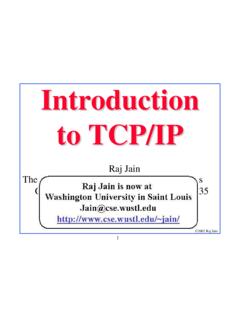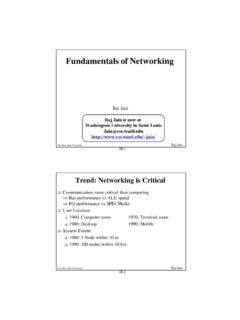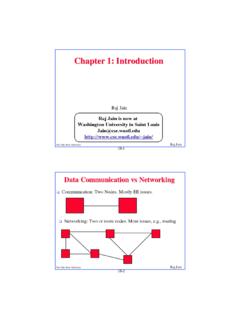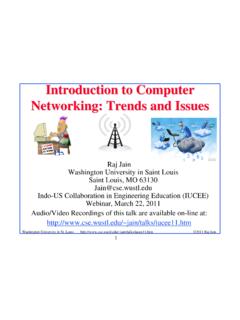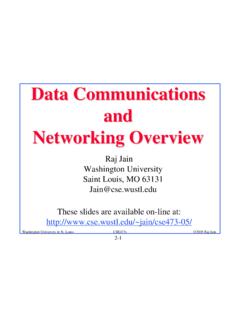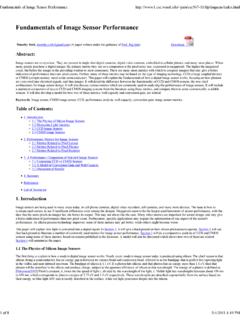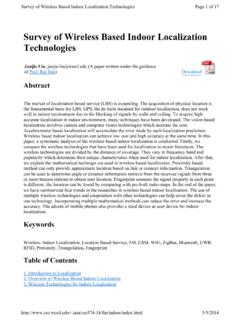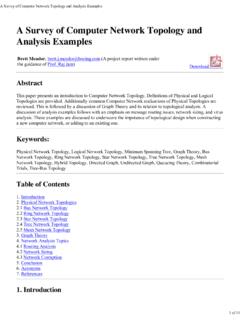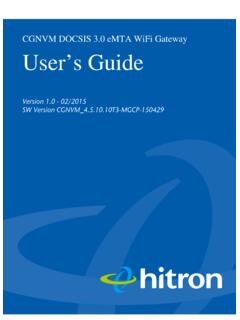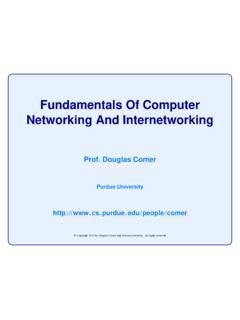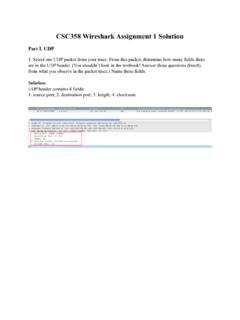Transcription of Introduction to Networking Protocols and Architecture
1 Raj JainThe Ohio State University2-1 Introduction toIntroduction toNetworking ProtocolsNetworking Protocolsand Architectureand ArchitectureRaj JainProfessor of CISThe Ohio State UniversityColumbus, OH slides are available on-line at: ~jain/cis677-00/Raj JainThe Ohio State University2-2 OverviewOverviewqData Comm vs Networking vs Distributed SystemsqTypes of NetworksqProtocol Layers: OSI and TCP/IP ModelsqConnection-oriented vs connectionlessqLayered packet formatRaj JainThe Ohio State University2-3 Data Communication vs NetworkingData Communication vs NetworkingqCommunication: Two Nodes. Mostly EE : Two or more nodes. More issues, ,routingRaj JainThe Ohio State University2-4 Distributed Systems vs NetworksDistributed Systems vs NetworksqDistributed Systems:qUsers are unaware of underlying , trn instead of \n\bone\0\trnqMostly operating systems are generally under one organization : Users specify the location of :\\ \~jain\qNodes are JainThe Ohio State University2-5 Types of NetworksTypes of NetworksqPoint to point vs BroadcastqCircuit switched vs packet switchedqLocal Area Networks (LAN) 0-2 km,Metropolitan Area Networks (MAN) 2-50 km,Wide Area Networks (WAN) 50+ kmWANBus LANRingLANRaj JainThe Ohio State University2-6 Protocol LayersProtocol LayersPhilosopherTranslatorSecretaryI believe there is a God!
2 QProblem: Philosophers in different countries speakdifferent languages. The Telex system works onlywith JainThe Ohio State University2-7 Design Issues for LayersDesign Issues for LayersqDuplexity:qSimplex: Transmit or receiveqFull Duplex: Transmit and receive simultaneouslyqHalf-Duplex: Transmit and receive alternatelyqError Control: Error detection and recoveryqFlow Control: Fast senderRaj JainThe Ohio State University2-8 ISO/OSI Reference ModelISO/OSI Reference ModelApplicationPresentationSessionTrans portNetworkDatalinkPhysicalHow to transmit signal: CodingTwo party communication: EthernetRouting, Addressing: IPEnd-to-end communication: TCPFile transfer, Email, Remote LoginASCII Text, SoundEstablish/manage connection123 Raj JainThe Ohio State University2-9 LayeringLayeringqProtocols of a layer perform a similar set of functionsqAll alternatives for a row have the same interfacesqChoice of Protocols at a layer is independent of thoseof at other layers.
3 , IP over Ethernet or token ringqNeed one component of each layer NullcomponentsSameInterfacesTrans Control ProtNovell Netware (IPX)Token RingInternet ProtocolEthernetCopperFiberFTPT elnetWebEmailUser Datagram ProtRaj JainThe Ohio State University2-10 SDUI nterfaces and ServicesInterfaces and ServicesqIDU = Interface Data Unit = ICI + SDUqICI = Interface Control InformationqSDU = Service Data UnitqPDU = Protocol Data Unit = Fragments of SDU +Header or Several SDUs + Header (blocking)qSAP = Service Access PointICISDUIDUSDUICIH eaderPDUSAPICISDUIDUSDUICISAPRaj JainThe Ohio State University2-11 Protocol Data Unit (PDU)Protocol Data Unit (PDU)ApplicationPresentationSessionTrans portNetworkDatalinkPhysicalAPDU, MessagePPDUSPDUTPDUNPDU, PacketDPDU, FramePhPDU, FrameApplicationPresentationSessionTrans portNetworkDatalinkPhysicalRaj JainThe Ohio State University2-12 Service Data Unit (SDU)Service Data Unit (SDU)ApplicationPresentationSessionTrans portNetworkDatalinkPSDUSSDUTSDUNSDUDSDUP hSDUP hysicalRaj JainThe Ohio State University2-13 Connection-Oriented vs ConnectionlessConnection-Oriented vs ConnectionlessqConnection-Oriented: Telephone SystemqPath setup before data is sentqData need not have address.
4 Circuit number is circuits: Multiple circuits on one : Postal System. Also known address on each packetqThe address decides the next hop at each routingpointRaj JainThe Ohio State University2-14 Types of ServicesTypes of ServicesqByte streams: user message boundaries are not preservedqRequest-reply: The reply serves as an acknowledgement alsoqMessage oriented or byte oriented approach can be used forunreliable connection-oriented communicationConnection-orientedDatagram ReliableUnreliableReliableUnreliableAckn owledgedRequest-ReplyMessageSequenceByte StreamRaj JainThe Ohio State University2-15 Service PrimitivesService PrimitivesqIndication = Interrupt1. Request2. IndicationHigher LayerLower LayerHigher LayerLower Layer12343. Response4. ConfirmUnconfirmed service: No confirmation or responseRaj JainThe Ohio State University2-16 TCP/IP Reference ModelTCP/IP Reference ModelqTCP = Transport Control ProtocolqIP = Internet Protocol (Routing)ApplicationPresentationSessionT ransportNetworkDatalinkPhysicalApplicati onTransportInternetworkHost to NetworkFTPTCPIPE thernetTelnetHTTPUDPP acketRadioPoint-to-PointTCP/IP Ref ModelOSI Ref ModelTCP/IP ProtocolsRaj JainThe Ohio State University2-17 OSI vs TCP Reference ModelsOSI vs TCP Reference ModelsqOSI introduced concept of services, interface, Protocols .
5 These were force-fitted to TCP later It is not easy to replace Protocols in OSI, reference model was done before TCP, Protocols were done before the modelqOSI: Standardize first, build laterTCP: Build first, standardize laterqOSI took too long to standardize. TCP/IP was alreadyin wide use by the become too is not general. Ad JainThe Ohio State University2-18 Layered Packet FormatLayered Packet FormatqNth layer control info ispassed as N-1th DataFTP HeaderTCP DataTCPH eaderIP DataIPHeaderEthernet DataEthernetHeaderEthernetTrailerRaj JainThe Ohio State University2-19 SummarySummaryqCommunication, Networks, and Distributed systemsqISO/OSI s 7-layer reference modelqTCP/IP has a 4-layer modelqPDU, SAP, Request, IndicationRaj JainThe Ohio State University2-20 Reading AssignmentReading AssignmentqRead Sections , , Appendix 1A, 1B, , and of Stallings 6th Protocols and Protocol StandardsqAppendix 1A: Standards organizationsqAppendix 1B: Internet TCP/IPRaj JainThe Ohio State University2-21 HomeworkHomeworkqVisit and find the titles of RFC1 andRFC137qCheck newsgroup and list anyone of the current issues being discussed thereqSubmit answers to Problems and of Stallings6th EditionqProblem : Communications between France andChinaqProblem.
6 Segmentation and Blocking
